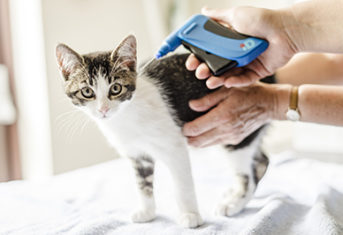Check the Chip Day Just Got Easier

Check the Chip Day Just Got Easier
August 12th is National Check the Chip Day. Microchips are a permanent form of identification for your pet. About the size of a grain of rice, a microchip is implanted under the skin in the nape of your pet’s neck. When scanned with a chip reader, the unique number of the chip shows in the display panel of the reader. The number of the chip is linked to your information in a chip registry. If your pet gets lost, the chip can be scanned and your pet can easily be returned to you. Veterinarians, animal shelters and animal control officers routinely scan stray pets hoping they have a chip and can be returned to their anxious family.
Does my pet have a microchip?
Your pet’s veterinarian’s office has a chip scanner. Next time you are there, ask to have the chip checked. Checking for a chip only takes a few seconds and you can probably just stop by to have the chip scanned. Once you know the chip number, put it into this handy microchip registry lookup tool. This tells you the registry associated with the chip, their website and telephone number. You then use that information to be sure your pet’s microchip is registered to your current name, address and phone number.
Other Reasons to Chip Your Pet
A microchip helps return a lost pet to you and proves you are the rightful owner of the pet. If there is any possibility you will travel internationally with your pet, a microchip is essential. Travel papers typically require the chip number be entered on each page of the official document. The chip number must also appear on documents like a rabies certificate for the rabies vaccination to be valid for international travel.
Checking the Chip Just Got Easier
The Baltimore County Department of Health and Human Services recently installed microchip reading stations in five locations throughout the county. If a Good Samaritan finds a lost pet, they can use the scanner at one of the stations to determine if the pet has a microchip. The scanning station has directions on how to scan. If a chip is found, the Good Sam can look up the number in an online database to get the owner’s contact information and reunite them with their pet. Hats off to Baltimore County for helping reunite pets with their families!
What to do if your pet is lost?
- Log on to your pet’s microchip registry and confirm your pet’s microchip registration is up to date.
- Put a lost pet alert on social media with a photo and information about your pet. I found a Manhattan NYC Lost Pets Facebook page which clearly works because there were responses from grateful pet families reunited with their companion animals.
- Check the website of your municipality for lost pet procedures.
- List your pet on the Petco lost pet website Petco Love Lost.
- Monitor the website of your local animal shelter or visit the shelter to look for your pet.
- Share your pet’s photo and description on neighborhood bulletin boards.

































